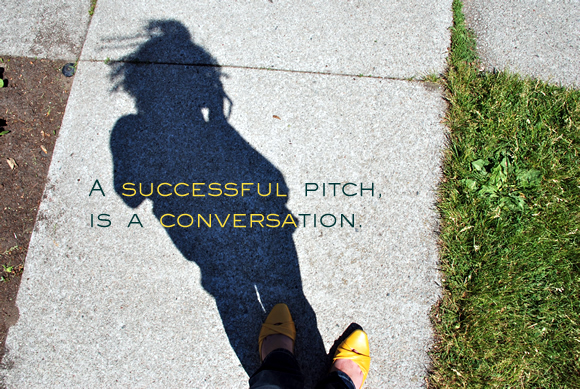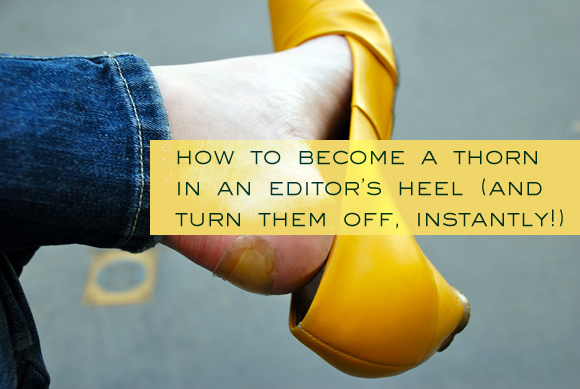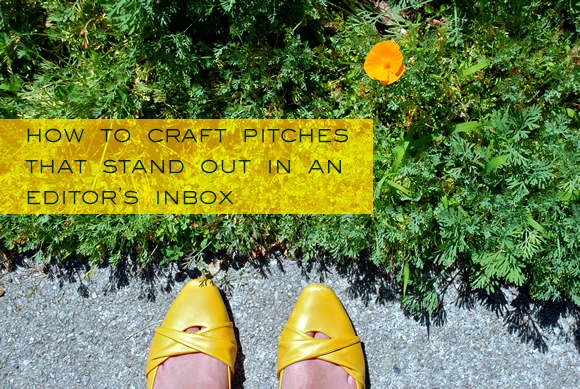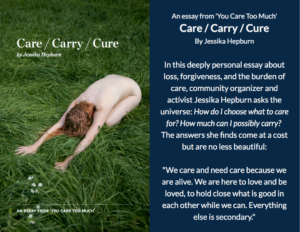
{All photos & text by Jena Coray, aka Miss Modish}
I approached lovely OMHG editor, Jessika, about doing a post on pitching to blogs, and she said, “I really want a post on how to pitch to blogs & the common things to ‘please for the love of all that is good’ do not do.”
Ask and you shall receive, Jessika! I can do that ;).
How to pitch to blogs, grab the editor’s attention and increase your likelihood of success (all while staying true to yourself):
When it comes to pitching, I’d like you to think of it not as “selling yourself” or “selling your brand” or “hyping yourself up” or anything that feels icky and slimy and marketing-speaky, because it doesn’t have to be like that. Not at all.
Pitching is communicating.
In a pitch, you want to communicate your brand, message, personality, professionalism, quality of product, friendliness and above all, your understanding of that blog’s style, audience and regular features. And you have to do it all in one fell swoop.
How on earth on are you supposed to do all that in a single e-mail?
Easy. By having a conversation.
And by taking the time to better understand who you’re conversing with, first.
I think the best way to learn how to effectively communicate with anyone, including blog editors, is to get a sense of their perspective. If we can better understand where they’re coming from, we can better understand how to approach them, and if our shop/product/service is a good fit.
Most of the real hard work of pitching, comes before you send the email–
- You’ll want to research each blog that you want to pitch– get to know what types of items and styles that they feature, what their aesthetic and taste is and whether what you make might fall within it. Check and see what style of jewelry they feature, if you make jewelry. Do the homework first!
- Check out their about page and learn a little about the editors that you want to converse with! See if they have any “about me” or “personal” categories on the blog that you could explore to get to know a bit more about their life and get a better sense of their perspective, and the commonalities you may share. Learn what food they like, what colors they like, what kind of pet they have.
- Really read their blog, check out the categories and archives and see what they’ve featured in the past. Make sure your shop/products/offerings are a good fit for that blog’s style, aesthetic and typical features before you even approach them about featuring you! Just because it’s your favorite blog, doesn’t mean your shop is necessarily a good fit for it- be discerning and objective about which blogs are the best matches for your brand!
- Talk to them! Bloggers LOVE to receive comments. If you have something to add to the conversation, please comment on the blogs you read, and the blogs you’re checking out as you research- and interact! It’s a great way to introduce yourself in an authentic way, if you comment from the heart. Bloggers are also all over social media- find them on twitter, facebook and pinterest and follow them, interact with them and start to build relationships with them!
Then, by the time you’re ready to send the email, you’ll be able to approach the blog editors with confidence and clarity, knowing that your shop/products are within the scope of the types of things they feature and their style.
And you’ll know a bit about the editors themselves and perhaps find some common ground you share, which can be a wonderful lead in to start your pitch conversation!
The pitches that stand out to editors the most sound like a human being talking to another human being. Like a chat between one individual to another.
The more they sound like a “sales pitch” or the same message you sent out to a bunch of people, the least likely you are to draw their attention.
Effective pitches are:
- Personal
A good pitch will address the editor by name, and acknowledge that you have familiarity with their blog, or them, in some way. And just like in person, if you’ve never communicated with them before, you’ll want to introduce yourself first, instead of acting like an old friend or their biggest fan (which feels slimy.)If you have had contact with them in some way before (on social media perhaps), acknowledge how you know them or where your conversation last left off. Just approach them as you would in person- friendly, polite and with a smile! (they can hear it, even if they can’t see it 🙂
- All about the visuals
If there’s one thing all design/art/handmade product blogs have in common, is that they’re all about the visuals! That means, the most effective pitches include can’t-resist, high-quality, showin’-your-stuff-off photos. An editor has solely your photographs to judge the product’s quality, style, craftsmanship and colors, so each pic has to be AWESOME.Honestly, you’d be better off not saying a word and attaching amazing photos of your great work, then you’d be chatting up how great your work is and attaching poorly lit, poorly styled photos of it. Your work has to speak for itself, so attach photos that can do some talkin’! - Short and sweet
Editor’s are short both on time and patience when it comes to an inbox filled to the brim with impersonal, off-target, ick-filled pitches. So to stand out, keep it short and sweet- a few paragraphs or less will do it, in a tone of professional friendliness and confidence.The pitch is not the place to share lots of background info, the inspiration for your work and why you’re the awesomest (eventho you totally are.) Think of the pitch as an invitation for them to click your link and enter your world, where they can explore and find all that out for themselves. Just say hello, share what you do, share a link, attach some pics and you’re done. Get them intrigued, and get out.
So now that you know what to do, let’s talk a bit about what not to do.

{please forgive this perfectly appropriate, yet mildly disgusting photo of my foot. This is from a trip to Minnesota to visit a friend a couple years ago- I wore the wrong shoes!}
For my Tip-Top Pitch Kit, an e-book I recently created all about how to pitch, I surveyed 28 popular design bloggers anonymously and asked: “What’s your biggest turn off in a pitch?” Here are the main points gathered from their collective responses, along with some *actual quotes from them…
Please, for the love of all that is good, do NOT:
- Address your email “Hello blogger,” “Hi there!” “Dear editor,” “Hello sir/madam”, “Dear Ms.”, “Attn OMHG Team”. Bloggers have names too- find them, and be sure to use them!
* “If they can’t find the time to figure out my name, I don’t have time to read their pitch.” - Copy and paste the same email out to every blogger, just changing the name on top, mass-mail to multiple people at once (even if you bcc), send a press release with no personal greeting, or sign a blogger up for your email list!
* “It’s a turn-off when it’s clearly a “form” email that they have just pasted my name in. That feels yucky. And also just a waste.” - Quickly glance at their blog before pitching to reference the latest post, or worse yet, not even look at the blog at all before pitching.
* It irks me when “someone references the last post up on the blog as fantastic instead of actually doing their research.” - Be self-deprecating or unsure about your talents/skills- have confidence in yourself!
* “I’ve received submissions that start out by saying, “I know you probably won’t feature this but…” If you don’t believe in your own work, why would I? Arrogance is a turn off but confidence is key.” - Be overly “familiar” if you don’t have an established relationship with the blogger already, or be overly gushy.
* “Don’t call me “sweetie”, “honey”, or “sugar pie” unless you’re Flo the waitress from Alice, a good friend, or related to me in some way.” - Include too much information in a pitch about your background or work- present links where they can find all that out if they’d like.
* “The work will speak for itself. Sometimes I find that when they go on and on about the work or product, I never end up liking it.” - Forget to attach stand-out, blog-worthy, well-lit, well-styled photos with your pitch! Make sure they’re web-resolution (72 dpi) and at least the width of the blog you’re pitching to.
* “Another turn off is terrible product photos. If a small biz doesn’t care enough about their product to have good photos, why should I care enough to do a feature?” - Attach a big pdf, document, media kit, lookbook or high-res photos- point them to where they can find them/download online, or let them know you have it additionally to send if they’re interested in seeing.
* It turns me off when “they attach a PDF or something crazy that takes way too long to open. The faster the better.” - Tell them that your product/shop would be good for their readership, or blogs- they know their own taste and readers best- make sure you’re on target, but let them be the judge!
* “I really hate it when people tell me that they thought something “would resonate with or appeal to your readers.” I’ll be the judge of that, thank you. Just tell me that you’re submitting X product for my consideration and respect me to do my job as an editor.” - Be overly aggressive in your approach, or condescending, or express frustration or annoyance if you hear back with a no (or don’t hear back at all). That’s the way to close the door on an opportunity!
* “It also irks me when people are overly aggressive with their pitches and express annoyance/anger that I haven’t featured them yet or act like it’s their right to have their product featured on my site.” - Suggest doing a giveaway to blogs that don’t do giveaways, or a diy project for a blog that doesn’t have a diy column, or a guest post for a blog that doesn’t accept guests- aka, do your homework first, always!
* “It’s really tough to take a pitch seriously when it’s clearly content or products I don’t typically feature. Do enough research to know what kind of posts I regularly feature and send me relevant content pitches and you’ll get my attention much quicker and easier.”
So now you know what to do in a pitch to stand out from the crowd, and what to clearly avoid in order to show the editors respect, courtesy and keep the doors of feature opportunities open!
It all boils down to: doing the research first, approaching the editors like you’re having a conversation with a real person (because you are) and presenting yourself with confidence, respect and a smile, because people can read genuine enthusiasm, care and friendliness- even if it’s between the lines.
What has been your experience pitching your shop/product/service to blogs so far? Do you have any fears, or hold-ups in contacting bloggers? Does this information change how you’ll approach your next pitch?
Editor’s note: Join Jena (@miss_modish) and I to talk about this fantabulous post + your questions live at our #OMHG Twitter chat this Thursday from 1-2EST! Also I know Jena’s marketing style is totally ick-free and non-pushy but I can push (or gently encourage with great love) you to check out her Tip Top Pitch Kit if you are having any trouble at all getting positive responses to your pitches. No affiliate links or sponsored review here I just honestly think this kit is packed with revelations and a-ha! moments to help you get the word out & know as a blogger I value every bit of her pitching wisdom!


